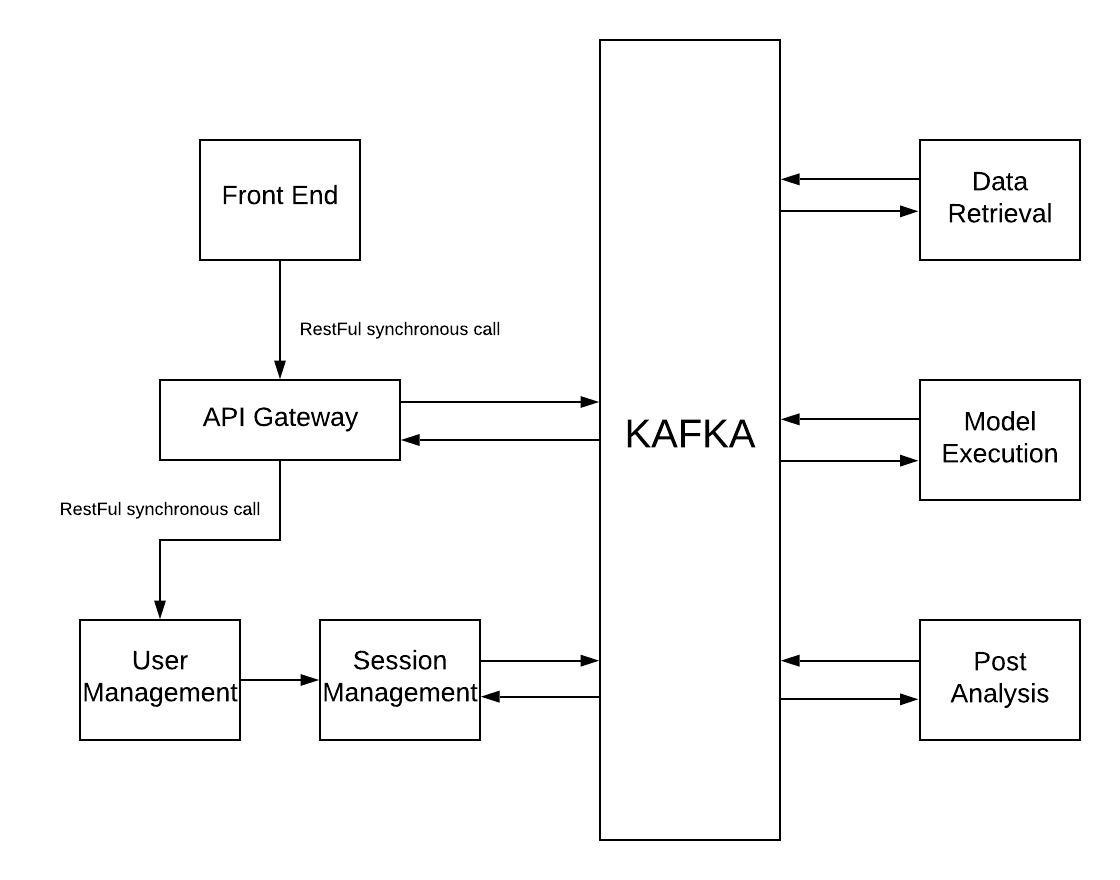This project aims to build a online weather prediction hosting platform.
For internal messaging between the microservices we have used Kafka. The frontend communicates with the API Gateway through RESTFul calls. The following features have been implemented.
- The frontend communicates to all the microservices via passing message through APIGateway.
- The APIGateway communicates to the UserManagement service using RESTful calls since we need synchronous functionalities.
- The rest of the communication is done using Kafka asynchronously.
- Session Management listens to each microservice and uses this to keep a track of all the services ran by the user.
- We have deployed some predifined models for Model Execution. The below figure can give a better idea of the architecture involved.
- The frontend sends a post request to /login or /register. If registering a user, we save the user information in a DB connected to the UserManagement API.
- Upon a logic request, the API Gateway sends a post request to /login. The user enters his/her information and upon verification the access to the dashboard is given. At the same time, the User Management API also sends a RESTful message the Session Management API to store the newly created session.
- The user logs in and this message is sent to the Session Management API via User Management API. The Session Management then retrieves the most recent session message for the recieved user through the unique userID we store in our User DB. This information is sent back to the User Management API via RESRful call. We use RESTful calls in this pipeline since it needs to synchronous and doint this through Kafka was really hard.
- The session listens to User Management via RESTful calls because of the need of synchonous calls.
- It uses kafka consumer to listen to all the other topics to keep track of all the jobs happening in any given action. We have a seperate topic for each API.
- The user requests for a model to execute. This requests goes to the API Gateway.
- The API Gateway sends this request as a message to the Data Retrieval API. The Data Retrieval API pulls the data the from a known link and stores it in "/Data" on the local machine. The Data Retrieval(DR) API then sends the name of the downloaded file through Kakfa to the Model Execution API.
- The Model Execution(ME) API recieves the message and calls a function to execute the model. The generated data is again stored in "/Data" and the name of the generated file is sent to the Post Analysis(PA) API using Kafka.
- The PA API then creates a .png plot file and sends this to the API Gateway through Kafka.
- The final data should be stored in the folder
\Data.
- We are unable to display results on frontend.
To run this application, make sure you have anaconda package for python, go and node.js installed.
- For installing nodejs follow instructions at https://nodejs.org/en/download/.
- Download and install anaconda v(3.7) from https://docs.anaconda.com/anaconda/install/.
- To install go, open up a terminal and type
$ sudo apt-get install golang. - This application uses Kafka as the main messaging service between services. To install kafka, follow https://kafka.apache.org/quickstart.
- To run this application, install py-ART package for nexrad dataset. This can be installed using the command
$ conda install -c conda-forge arm_pyart. Make sure you have anaconda installed before running this. If you have aconda command not founderror, make sure you have added the path to your anaconda3 directory in your ~/.bashrc file.
Follow the below instructions. Move to clone directory.
- Starting Kafka. Change to the directory where kafka is extracted.
- For Zookeeper, run
$ bin/zookeeper-server-start.sh config/zookeeper.properties. - For Kafka, run
$ bin/kafka-server-start.sh config/server.properties. - Use the command
$ bin/kafka-topics.sh --create --bootstrap-server localhost:9092 --replication-factor 1 --partitions 1 --topic topic-namefor the topicsapigateway, DataRetrieval, modelexecution, postanalysis, addAction. - Use
$ bin/kafka-topics.sh --list --bootstrap-server localhost:9092to list out all the topics. Make sure all the topics mentioned above have been created.
- Run the API Gateway service
$ cd SquirtleSquad/APIGateway$ npm install$ npm run dev
- Run the User Management service in a seperate terminal.
$ cd ../UserManagement$ npm install$ npm run dev
- Run the Session Management service in a seperate terminal.
$ cd ../SessionManagement$ npm install$ npm run dev
- Run the Data Retrieval service in a seperate terminal.
$ cd ../DataRetrieval$ go get github.com/Shopify/sarama$ go build kafka-connectors/connector.go$ go run kafka-connectors/connector.go
- Run the Model Execution service in a seperate terminal.
$ cd ../ModelExecution$ python ModelExecution.py
- Run the Post Analysis service in a seperate terminal.
$ cd ../Inference$ python Inference.py
Once everything starts running up, the application can be accessed using localhost:8080/.
#NOTE :
- The current running branch is
apiexec
Anurag Kumar
Sathyan Venkatanarayanan
Shanmukha Surapuraju
